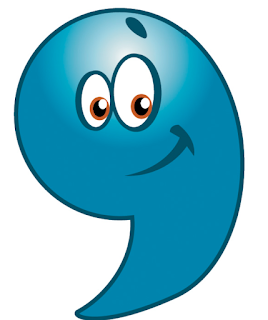What is a comma (,)?
It is a punctuation mark that indicates a
smaller break than a period. Some writers think of a comma as a soft pause—a
punctuation mark that separates words, clauses, or ideas within a sentence.
When do we use comma?
1.- When joining two independent clauses.
We were out of milk, so I went to the store.
Or, you can simply write the two independent
clauses as separate sentences.
We were out of milk. I went to the store.
2- After an introductory phrase
Participial phrases: Grabbing her umbrella,
Kate raced out of the house.
Adverbial phrases: Unfortunately for me, I can’t
speak Italian.
3.- With interrupters or parenthetical
elements
The weather, I was happy to see, was beginning
to clear.
It was,
sadly, the last day of camp.
4.- With a question tag
These willow trees are beautiful, aren’t they?
5.- When addressing another person
Mom, I can’t find my shoes!
6.- With nonessential appositives
An appositive is a word or phrase that
refers to the same thing as another noun in the same sentence.
My sister, Angela, is a wonderful cook.
7.- In dates when writing a date in month-day-year format,
set off the year with commas.
July 4, 1776, was an important day in American
history.
I was born on Sunday, May 12, 1968.
8.- Between coordinate adjectives to modify a
noun to an equal degree.
That man is a pompous, self-righteous,
annoying idiot.
The scintillating, sweet aroma of cinnamon
buns filled the kitchen.
9.- Before 'but' when joining two independent clauses:
Cleo is a good singer, but she’s an even
better dancer.
10.- In lists with three or more elements.
Julie loves ice cream, books, and kittens.
Julie loves ice cream, books and kittens.
11.- For sequenced events, it is used the serial
comma as known as Oxford comma
I still have to buy a gift, pack the
suitcases, and arrange for someone to water the plants while we’re at the
wedding.
I still have to buy a gift, pack the suitcases
and arrange for someone to water the plants while we’re at the wedding.
12.- With nonrestrictive clauses
Posey’s Cafe, which Chester recommended, is a
fantastic restaurant.
My wife, whom I love dearly, is a brilliant
physicist.
13.- Between direct quotes and attributive tags
An attributive tag is a phrase like 'he said' or 'she claimed' that identifies the speaker of a quote or piece of dialogue.
The professor remarked, 'How attentive you
have been today!'
'Once you know the solution,' Tiffany said, 'the whole problem seems very simple.'
'You have ice cream on your nose,' my friend
snickered.
'When you leave the house,' my mother yelled, 'don’t slam the door!'
14.- Inside quotation marks
'Pass me that thesaurus,' said Matthew.
'If you knew what was good for you, you’d sit
down and finish that essay right now,' my roommate said.
'We’re going down to the soup kitchen to help
serve dinner,' her mother called.
15.- With 'such as'
The phrase 'such as' requires commas if it
introduces a nonrestrictive clause.
Coniferous trees, such as pine and spruce, do
not drop their needles in the winter.
16.- Before 'too' to add emphasis
Using a comma before 'too' is optional.
I like bananas too.
I like bananas, too.
I too like bananas.
I, too, like bananas.
A comma simply adds emphasis.
I like bananas, too.
I, too, like bananas.
Source:
GRAMMARLY (2023) Rules for Using Commas on https://www.grammarly.com/blog/comma/
Collaborative Online Exercise about the use of comma
https://www.englishrevealed.co.uk/FCE/fce_writing_punctuation/fce_writing_4.php
Individual Online Exercise about the use of comma
https://webapps.towson.edu/ows/exercises/CommaUse%20-%20Exercise%2001.aspx
Last Update by Dark Prince in 2024




No hay comentarios:
Publicar un comentario